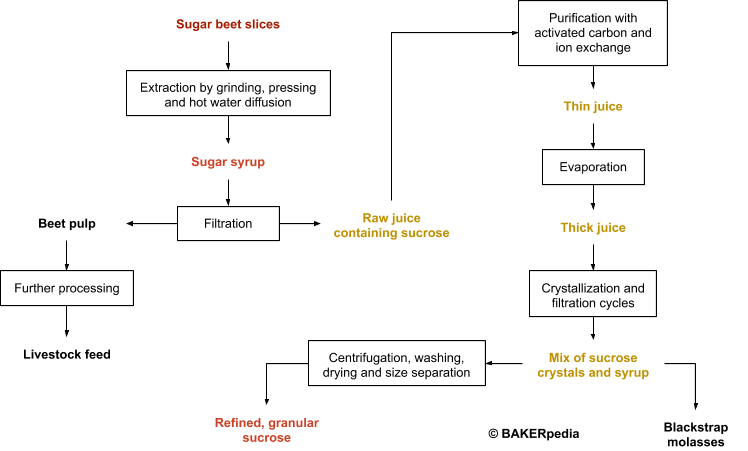
We all know that sugar is essential for bakingafter all its what makes sweets taste sweet. Sugar is also used in biscuit cream fillings in the form of icing sugar since the finer particle size gives a smoother mouth feel and a rapid dissolution of the sugar in the mouth.

So what is the science of sugar.
Function of sugar in baking. Sugars Functions in Baking While we all know that sugar sweetens baked goods it actually plays many different roles in baking regarding the structure texture and color of baked goods. Sugar Sweetens Flavors The first and most obvious role of sugar in baking is that it adds sweetness and flavor. Science of Sugar in Baking.
Sugar is hygroscopic meaning it has a tendency to attract and hold onto water molecules. This characteristic of sugar helps make and keep baked goods moist. Sugar interferes with the coagulation of proteins.
Sugar can bind to water molecules slowing moisture loss and preventing staleness in baked goods. In addition the glucose fructose mixture in invert sugar present in jams and jellies helps to inhibit microbial growth and later spoilage. Fermentation an extremely important process in the baking industry is fuelled by sugars.
We all know that sugar is essential for bakingafter all its what makes sweets taste sweet. But thanks to its unique chemical nature real sugar the sugar that comes from sugar beets and sugar cane and is often referred to as table sugar or granulated sugar also performs many other essential functions in cookies cakes and other baked goods. While beating the cake mixture the addition of sugar helps cut the batter and create tiny bubbles.
This makes the cake fluffy and light causing the cake to rise when baked. Sugar keeps baked goods soft and moist and it does a lot more than just satisfy our craving. The bond between sugar and water allows sugar to lock in moisture so that items such as cakes muffins brownies and frostings dont dry out too quickly.
It creates tenderness deepens colour and flavour and adds crunch. Hey guysSugar despite the bad reputation it often gets is a vital ingredient when it comes to baking and we certainly shouldnt skip on it before we know. Professional chefs will tell you that baking is just as much science as it is an art.
So what is the science of sugar. Each ingredient plays a part in the chemical reaction that happens when your cake cookies and pies go in the oven. Even tinkering with just one of the ingredients can affect whether you end up with a dry hard imperfect creation or a flawless one.
Glucose and dextrose are the same chemical alpha-D-glucopyranose which is a simple sugar. This sugar has a clean pleasant sweet taste but is not quite as sweet as the table sugar sucrose. It is used in baking for sweetening and sensory attributes.
Sugar plays an important role in most baking applications as it helps to promote lightness in baked goods by interacting with leavening agents to create small air cells. The Function of Sugar in Baking Sugar does much more in baking than just imparting a sweetness of flavor although this is of course an important function of sugar. Its various forms from simple granulated sugar to the more complex caramel honey and molasses each offer a different type of sweetness to the baked product.
Sugar is undoubtedly the biggest part of what makes cookies such a treat and after all what satisfies our sweet tooth. Its use is up there with the use of flour which is THE ingredientBut do you know what it really does and how it affects the biscuit baking process and in the end the product itself. Were here to shed some sweet light on this subject.
Liquid glucose often referred to as glucose syrup is a liquid form of simple sugar. It tends to keep products soft and moist so is often used in icings such as royal icing to stop them from becoming hard and sometimes in baking to keep products soft and moist. In most domestic baking it would be more common to use invert sugars such as.
Sugar is also used in biscuit cream fillings in the form of icing sugar since the finer particle size gives a smoother mouth feel and a rapid dissolution of the sugar in the mouth. The Use of Sugar in Baking. The sweetening property is the most basic function of sugar which makes it an important ingredient for use in bakery.
Sugar is hygroscopic meaning it has a tendency to attract and hold onto water molecules. This characteristic of sugar helps make and keep baked goods moist. Sugar interferes with the coagulation of proteins.
Adding more sugar to a cake recipe causes the proteins in the flour and eggs to form weaker bonds creating a more tender softer crumb. The Function of Sugar in Baking In addition to providing sweetness sugar adds flavor bulk and structure. In cakes without shortening sugar helps delay egg coagulation and allows a cake to set properlyIt also retains moisture in baked goods.